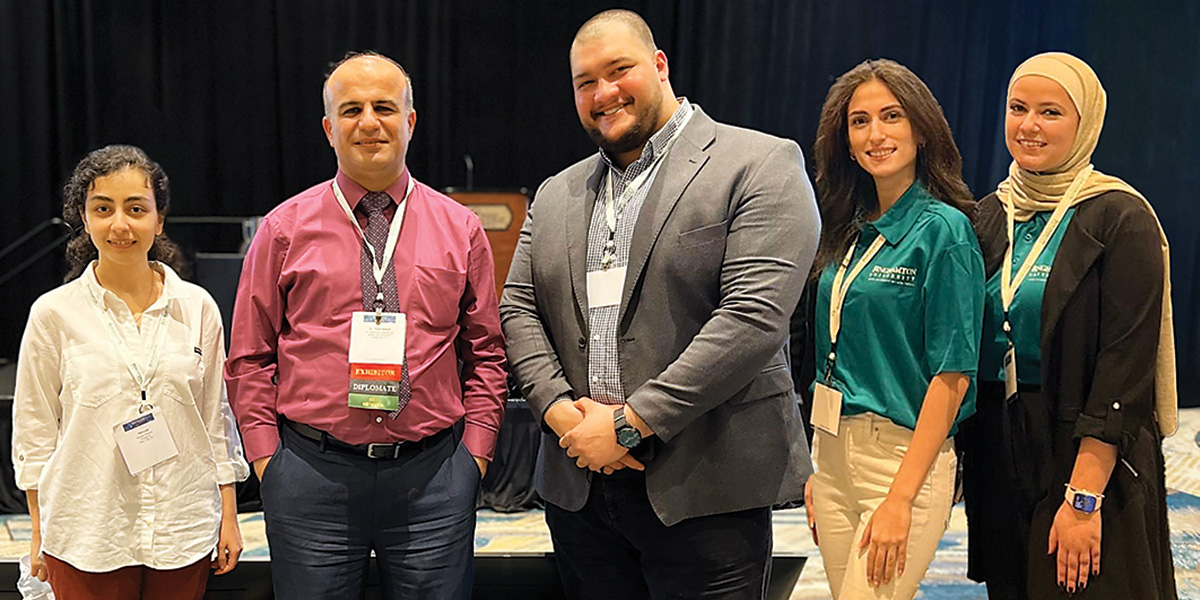Watson SSIE graduate students excel in competition to improve healthcare
Teams present and defend solutions about patient dissatisfaction with emergency rooms

Three thousand miles and conflicting time zones couldn’t stop Watson College students from coming out on top in an international healthcare simulation competition.
Maryam Hosseini, Ali Rawabdeh, Lubna Tarawneh and Sarah Sawaqed, MS ’22, all from the Department of Systems Science and Industrial Engineering, continued the college’s winning streak at the Healthcare Systems Process Improvement Conference (HSPIC) by capturing first and second place in 2022.
In September 2021, they were prompted to simulate an improved emergency room system using FlexSim software — a modeling program none of them were familiar with at the beginning of their journey. After a couple of months of research, the team was invited to present and defend a solution before a panel of healthcare professionals.
Emergency rooms are known for how chaotic they can be, with the average person encountering wait times of more than an hour, depending on the volume of visits, according to the Centers for Disease Control and Prevention. These students had to discern and pinpoint the underlying causes for patient dissatisfaction, such as staff scheduling, uneven resource consumption, machine access and capacity constraints, and then plot a method to allow for a balanced and streamlined flow — all while also taking into consideration cost effectiveness.
The winning team of Hosseini and Rawabdeh, both doctoral candidates in industrial and systems engineering, was separated by a 3,000-mile difference. Hosseini conducts her research at a New York City-based architectural design company called EwingCole, while Rawabdeh conducts his graduate research at a manufacturing company based in California. It meant they had to rely almost entirely on Zoom to discuss their ideas and collaborate.
“We were in different time zones, so we had to learn time management as a skill and to be more organized,” Hosseini says. “We usually met over the weekends to brainstorm and divide the work between ourselves, all in three hours. We both are a part of WISE [Watson Institute for Systems Excellence] and spend a lot of time on our own individual research, but Ali was good about attending, participating and collaborating, so it worked out really well.”
Rawabdeh believes the team dynamic and passion were the largest factors for their win. However, focusing their approach and efforts was sometimes a struggle.
“The huge difference between our approaches to problems gave us a lot of opportunity to think in a wide way,” Rawabdeh says. “She [Hosseini] was thinking from one point of view while I was thinking from a totally different point of view, and finally we could find the one middle point between us that combined both ideas and experiences to accomplish the main goal. It was a really good exercise for me to work with someone from a completely different background intellectually.”
For Tarawneh, an ISE doctoral candidate who was part of the second-place team, the hardest part of the competition was just how far out of the box she and her partner, Sarah Sawaqed, had to think while breaking down the issue.
“The innovation in the solution was very chal- lenging because the case study involved assisting emergency department leadership to optimize operations in their own department,” Tarawneh says. “You definitely need to be creative and have your own approach to solve it.”
Both teams were allowed a faculty advisor: Hosseini and Rawabdeh worked closely with Mohammad Khasawneh, distinguished professor and chair of the SSIE department, while Tarawneh and Sawaqed partnered with SSIE Professor Sangwon Yoon.
The mentors were only allowed to give “three drops of sugar,” in Yoon’s words — meaning they were there to track the students’ progress and to ask guiding questions.
“I’ve been working on research in the healthcare industry for over 15 years. When the team came
to me with an idea, I could say, ‘We already tested that in a hospital and it provided really good results’ or ‘Most hospital managers wouldn’t agree to this because it costs a lot of money,’” Khasawneh says. “Overall, I guided them throughout the process and reviewed their report, their presenta- tion and their practices, but they did all the work.”
Besides aiding in finding improvements for hospitals and other healthcare systems, simulation has applications in many fields.
“I love the fact that you can always do process improvement,” Tarawneh says. “We can see it being applicable in different areas: in healthcare, in manufacturing and other sectors. It combines different aspects like operations research, simulations and machine learning into one.”
